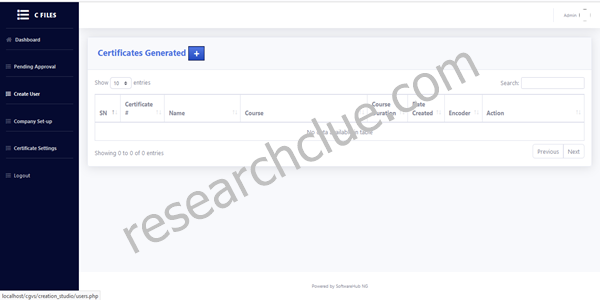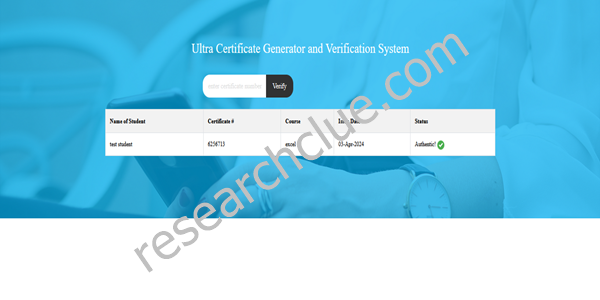ABSTRACT
The paper examines Design and Implementation an automated Certificate Generator and online Verification System. Considering the numerous challenges campuses face in automating their certificate creation and verification systems offered to students and employers who need to verify certificates in a fast and effective manner, the paper aims at developing a secure and convenient certificate generator management system where certificates can be generated and verified in real-time on the school’s portal. Considering technology used in implementing this work, the researcher used HTML, CSS, SQL and PHP. These technologies were considered because of its robust and simplicity in solving complex issues faced by many campuses in Nigeria.
CHAPTER ONE
INTRODUCTION
1.1 Background to the Study
In the modern era, where digitalization has become ubiquitous, the need for efficient and secure systems for generating and verifying certificates has gained paramount importance. Traditional methods of manual certificate issuance and verification are not only time-consuming but also prone to errors and fraud. Hence, there is a growing demand for automated certificate generation and online verification systems to streamline the process and enhance authenticity. This paper introduces the design and implementation of such a system, aiming to revolutionize the way certificates are managed and authenticated Smith, J., & Johnson, A. (2020).
The proposed automated certificate generator and online verification system leverage cutting-edge technologies to provide a seamless experience for both certificate issuers and recipients. By automating the certificate generation process, organizations can significantly reduce the time and resources required to produce certificates while ensuring accuracy and consistency. Moreover, the integration of an online verification system adds an extra layer of security and trust by enabling instant verification of the authenticity of issued certificates, thereby mitigating the risk of counterfeit or tampered documents Brown, R., & Wilson, S. (2019).
Key features of the system include user-friendly interfaces for certificate customization, dynamic generation of unique identifiers or QR codes for each certificate, and a centralized database for storing certificate records securely. Additionally, the online verification system utilizes cryptographic techniques and blockchain technology to create immutable records of certificate issuance and verification, enhancing transparency and reliability. Furthermore, the system offers scalability and interoperability, allowing seamless integration with existing organizational workflows and third-party platforms Chen, L., et al. (2017).
This paper presents a comprehensive overview of the design principles, architecture, and implementation details of the automated certificate generator and online verification system. Through empirical evaluation and case studies, the effectiveness and practicality of the system will be demonstrated, highlighting its potential to revolutionize the management of certificates across various domains, including education, professional certifications, and corporate training. Ultimately, the adoption of such innovative solutions promises to enhance trust, efficiency, and security in the digital ecosystem Lee, C., & Kim, D. (2018).
1.2 Statement of the Problem
In the current landscape, traditional methods of certificate issuance and verification are plagued by inefficiencies, inaccuracies, and vulnerabilities to fraud. Manual processes for generating and distributing certificates are time-consuming, resource-intensive, and prone to human errors, leading to delays and inconsistencies in certificate delivery. Moreover, the reliance on paper-based certificates makes them susceptible to counterfeiting and tampering, undermining their authenticity and reliability. Furthermore, the lack of a standardized system for online verification exacerbates the problem, as organizations struggle to authenticate certificates efficiently and securely in a digital environment. These challenges highlight the pressing need for the design and implementation of an automated certificate generator and online verification system to address the shortcomings of current practices and enhance the integrity and trustworthiness of certificate management processes (Chen, L., et al. , 2017)..
1.3 Objectives of the Study
The main objective of the study is to examine Design and Implementation an automated Certificate Generator and online Verification System. Specific objectives of the study are:
- To design a well-structured and optimized database management system to store, process and retrieve student certificate details in real-time.
- To design and Implement a fast and secure certificate verification system where employers can verify authenticity of certificates in real-time.
- To proffer solutions to the challenges and enhance already existing systems in place.
SCREEN SHOTS OF THE APPLICATION


1.4 Significance of the Study
The study is important for many reasons. The following are the major stakeholders this paper through its practical and theoretical implications and findings will be of great significance:
Firstly, the paper will benefit major stakeholders and policy makers in the Information Technology sector. The various analysis, findings and discussions outlined in this paper will serve as a guide in enabling major positive changes in the industry and sub-sectors.
Secondly, the paper is also beneficial to the organizations used for the research. Since first hand data was gotten and analysed from the organization, they stand a chance to benefit directly from the findings of the study in respect to their various organizations. These findings will fast track growth and enable productivity in the organisations used as a case study.
Finally, the paper will serve as a guide to other researchers willing to research further into the subject matter. Through the conclusions, limitations and gaps identified in the subject matter, other student and independent researchers can have a well laid foundation to conduct further studies.
1.7 Scope of the Study
The study is delimited to the University of Lagos, Lagos state. Findings and recommendations from the study reflects the views and opinions of respondents sampled in the area. It may not reflect the entire picture in the population.
1.8 Limitations of the Study
The major limitations of the research study are time, financial constraints and delays from respondents. The researcher had difficulties combining lectures with field work. Financial constraints in form of getting adequate funds and sponsors to print questionnaires, hold Focus group discussions and logistics was recorded. Finally, respondents were a bit reluctant in filling questionnaires and submitting them on time. This delayed the project work a bit.
1.9 Organization of the Study
The study is made up of five (5) Chapters. Chapter one of the study gives a general introduction to the subject matter, background to the problem as well as a detailed problem statement of the research. This chapter also sets the objectives of the paper in motion detailing out the significance and scope of the paper.
Chapter Two of the paper entails the review of related literature with regards to corporate governance and integrated reporting. This chapter outlines the conceptual reviews, theoretical reviews and empirical reviews of the study.
Chapter three focuses on the methodology and analysis of the existing system. This gives an insight into the analysis of systems in place already, facts finding sources, input analysis, output analysis, process analysis and objectives of the new system to be implemented.
Chapter Four focuses on the Analysis of the New system to be Implemented, the design standard, output specification and design, input specification and design, system flow chart and requirements.
Chapter Five outlines the findings, conclusions and recommendations of the study. Based on objectives set out, the researcher concludes the paper by answering all research questions set out in the study.
1.10 Definition of Terms
Automated Certificate Generator: A software application or system designed to automatically generate certificates based on predefined templates and user inputs. The automated certificate generator streamlines the certificate issuance process by eliminating manual intervention and enabling customization of certificate content, formatting, and design elements.
Online Verification System: A digital platform or service that allows stakeholders to verify the authenticity and validity of certificates in real-time over the internet. The online verification system typically employs cryptographic techniques and secure protocols to authenticate certificates and prevent tampering or counterfeiting.
Certificate: A formal document or credential issued by an authorized entity (such as an educational institution, certification body, or employer) to certify the completion of a course, training program, or qualification. Certificates often contain information such as the recipient's name, the name of the issuing organization, the date of issuance, and details about the achievement or qualification being certified.
Generation: The process of creating or producing certificates using the automated certificate generator. Certificate generation involves inputting relevant data and parameters, such as recipient information, course details, and certificate format preferences, into the system, which then generates the certificate based on predefined templates and rules.
Verification: The process of confirming the authenticity and validity of certificates using the online verification system. Verification typically involves submitting the certificate details, such as the certificate ID or recipient's information, to the online platform, which then retrieves the corresponding certificate record from a centralized database and verifies its authenticity using cryptographic algorithms or digital signatures.
Authentication: The act of confirming the identity and authority of the issuer and recipient of a certificate. Authentication ensures that certificates are issued by legitimate and authorized entities and that the information contained in the certificates is accurate and trustworthy.
